
Presenting like Steve Jobs: Using 6 of His Proven Techniques – Here’s How It Works!
The art of presenting has gained transformative significance in today’s business world. A presentation is no longer just a sequence of slides; it’s a way to communicate ideas, establish connections, and inspire the audience.
When discussing inspiring presentations, the name Steve Jobs inevitably comes up. He elevated the art of presenting to a new level. Today, we’ll showcase the techniques Steve Jobs utilized and how you can apply them to your own presentations.
Who is Steve Jobs?
Born in 1955 in California, Steve Jobs is renowned as one of the co-founders of Apple. He is considered one of the m ost prominent figures in the computer industry.
Steve Jobs is equally renowned for his exceptional presentation skills . His presentations are enduringly memorable. They were not only informative but also captivating events that held the audience spellbound. His charismatic presence, persuasive rhetoric, and minimalist design fundamentally transformed the way we present.
Why Steve Jobs Is a Model for Successful Presentations
As the presenter of Apple’s products, Steve Jobs amassed a wealth of experience. Over time, he established a reputation as a master of presentation . Through specific techniques, he managed to do more than convey information; he left an impression, stirred emotions, and enthused the audience . His presentations were more than mere business demonstrations; they were powerful performances that captivated the audience.
Behind every “One more thing” by Steve Jobs lies an array of techniques with the potential to elevate presentations to a new level. His charismatic presence, storytelling prowess, and distinctive presentation style have set a benchmark for modern presenting. The way he engaged the audience and conveyed his messages has made him an exemplar from which presenters worldwide can learn.
The Impact of Steve Jobs’ Presentations on the Technology and Business World

The influence of Steve Jobs’ presentations extends far beyond the technology industry. The styles he used revolutionized entire presentation formats. His innovative approaches and techniques set standards that go well beyond the stage. His charisma, storytelling abilities, and captivating audience engagement transformed the understanding of what makes a compelling presentation, ushering in a new era of presenting.
Jobs’ presentation philosophy demonstrated that a well-crafted presentation is not just about conveying information; it’s an opportunity to captivate, inspire, and persuade the audience.
6 Techniques from Steve Jobs for Captivating and Convincing Presentations
Steve Jobs employed the following techniques to his advantage:
1. Simplicity and Clarity
Simplicity and clarity are crucial factors for all types of presentations. Nobody wants to hear complex content delivered in the most convoluted way. Steve Jobs had the ability to transcend complexity through simplicity.
He understood that cluttered slides and confusing information overwhelm the audience and blur the messages. Instead, Steve Jobs embraced minimalism and clarity by reducing his presentations to the essentials.
This minimalism was reflected in his slides, often composed of just a few words or an image that illustrated the central message . Focusing on the essentials also helps your audience understand your key points better and faster. Simplicity doesn’t equate to shallowness. Skillfully direct your listeners’ attention by operating in a minimalist manner and projecting only the most important messages to reinforce.
2. Storytelling
To keep your audience engaged, you should always use storytelling. Incorporating your content into a story using this technique helps maintain attention spans and convey your message more effectively. More in-depth tips can be found in the article “ Storytelling in Presentations .”
Steve Jobs also knew how to use storytelling. He was a true master of storytelling, taking his audience on an emotional journey . In his presentations, he built suspense by following a clear structure resembling a classic narrative: introduction, plot development, and a captivating conclusion . He also integrated personal stories, authentically conveying his passions and beliefs. This created a common ground with his audience and lent a human touch to his presentation.
He understood that compelling presentations should rely not only on facts and logic but also on emotions. Jobs appealed not only to the minds but also to the hearts of his audience.
If you also use storytelling, your audience is more likely to identify with the ideas you present . This means that you have a higher chance of generating sales or new customers. At the same time, storytelling creates an unforgettable presentation experience for your audience. And staying in their minds for a long time also leaves a good impression.
3. Visual Presentation Aids
Nobody enjoys reading text-heavy PowerPoint slides. Therefore, like Steve Jobs, you should always rely on supportive visual presentation aids. When used skillfully, these aids are not only visually appealing but also reinforce your messages and better reach your audience.
Such presentation aids can include images, videos, or graphics . Steve Jobs used these primarily to illustrate abstract concepts, demonstrate products in action, and evoke emotions. These visual presentation aids weren’t just for decoration; they were integral parts of the story he told.
4. The Art of Staging
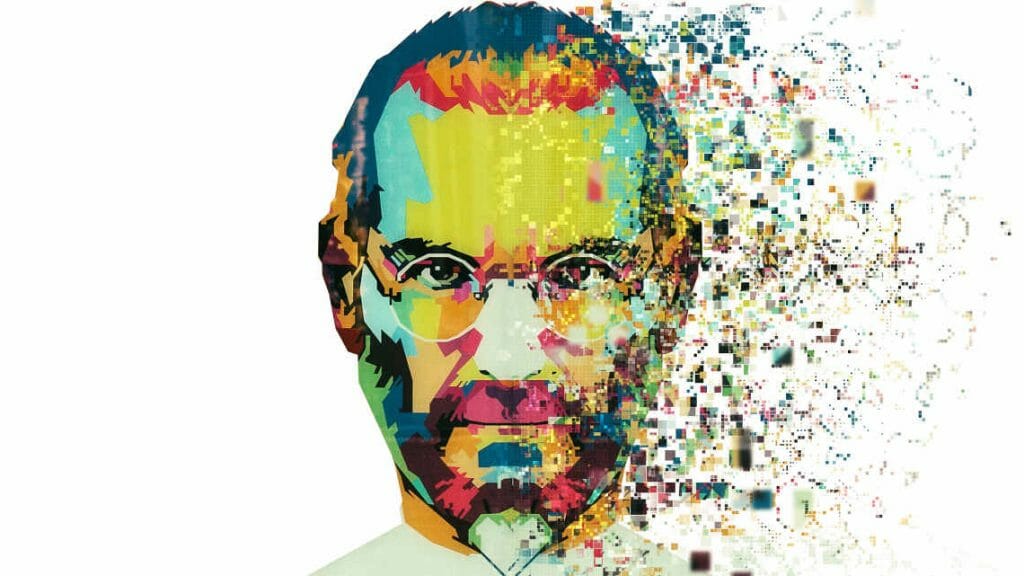
Many presenters overlook this: a presentation is not just about compelling slides and a good delivery, but also about effective staging . One of the most captivating aspects of Steve Jobs’ presentation style was his masterful staging. Jobs understood that a presentation is not only about content but also about how it is presented.
His appearances were meticulously choreographed , from his stage entrance to the sequence of slides. Every step, movement, and pause was intentionally planned to captivate the audience and convey messages with maximum impact. He utilized silence and pauses to build tension, employed gestures and facial expressions to convey emotions, and mastered perfect timing to direct the audience’s attention.
You don’t necessarily need to be as meticulously planned as Steve Jobs, as that requires intense preparation and practice . Nonetheless, strive to be conscious of what you radiate, how you behave, and what reactions your actions evoke in your audience. A test audience is an excellent way to practice.
Tips for exuding confidence, appropriate body language, and conscious use of language can be found in the following articles:
- Body Language in Presentations
- Speech Techniques in Presentations
5. Innovation and “One More Thing”
You’ve probably heard of Steve Jobs’ “One More Thing.” It’s the hallmark of Steve Jobs’ presentation style. He managed to spice up his presentations with a touch of innovation and surprise . This distinctive technique, known as the “One More Thing,” was a masterpiece in building suspense and last-minute revelations.
Steve Jobs’ audience was familiar with this effect, and Jobs intentionally created expectations by leading his audience through the main presentation, only to deliver an unexpected bombshell at the end. In his case, the surprises were groundbreaking product announcements or innovative features that captivated the audience. With the “One More Thing” technique, Jobs adeptly engaged his audience and held their attention until the very end.
Like Steve Jobs, strategically place well-timed surprises to harness the potential to make a presentation unforgettable and leave a lasting impact.
6. The Right Conclusion
A convincing conclusion is crucial for any type of presentation. Avoid the usual “Thank you for your attention” phrase and aim for memorable presentation endings.
Steve Jobs’ conclusions were often powerful and unforgettable, leaving a lasting impression on the audience. He also employed the “One More Thing” technique to end with a surprising revelation that left the audience in awe. This technique not only generated excitement but also left the audience with a sense of wonder and enthusiasm.
Furthermore, Jobs’ conclusions always had a clear connection to his message or main theme . He summarized the key points of his presentation and emphasized the core messages once again. This technique helps your audience internalize and remember the most important key points as the presentation concludes.
For more helpful tips on a successful conclusion, refer to the article “ 20 Ideas for Your Presentation Ending .”
If you want to see a speech of Steve Jobs please have a look here . Use the english subtitles if needed.
Conclusion: Applying Steve Jobs’ Techniques Strategically and Convincingly
Follow the example of Steve Jobs and enhance your future presentations to be more engaging and persuasive. Apply the techniques we’ve presented and captivate your audience.
Do you have questions about this article? Feel free to reach out to us via email at [email protected] . We are here to assist you!
If you are looking for visually supportive and professionally designed slide templates, explore our shop. We offer a wide range of slides prepared for various (business) topics available for download. Visit our shop today! ► Shop
You might also find these articles interesting:
- Storytelling in Presentations
- Preparing Presentations: 11 Tips
- 20 Ideas for Your Presentation Ending
- Learning from Hitchcock: How to Deliver Captivating Presentations
Share this post
- share
- save

Design Thinking: Problem Solving with a Difference

Why Corporate Mission Statements Are So Important

7 Tips & Learnings from the Apple Keynote

How it works
For Business
Join Mind Tools
Book Insights • 15 min read
The Presentation Secrets of Steve Jobs: How to Be Insanely Great In Front of Any Audience
Carmine gallo.
By the Mind Tools Content Team

Welcome to the latest episode of Book Insights from Mind Tools.
In today's podcast we're looking at The Presentation Secrets of Steve Jobs, subtitled How to Be Insanely Great In Front of Any Audience, by Carmine Gallo. It explores what makes Apple's CEO and co-founder such a captivating speaker – and how we can learn from his techniques.
When it comes to presentations, most people who've seen him speak agree that Steve Jobs is a legend. His talks do much more than just give information. They're events. They inspire, excite, spark imagination, and build a following.
Seeing Jobs speak is like spending an evening watching a high-quality theater production. And this is a big reason why people will spend all night, in freezing temperatures, waiting in line just so they can get a good seat.
So, how does he do it? How does Jobs manage to turn a relatively dry subject like computers into a seductive experience that everyone wants tickets to go see?
Well, that's what this book sets out to explain. The Presentation Secrets of Steve Jobs passes on the tips, techniques, and tricks that make the legendary leader's presentations so inspiring and effective. Reading this book is like getting coaching sessions from the master himself.
Here, you learn how Jobs crafts his messages, presents his ideas, generates excitement, and creates a memorable experience for his audience. And, it's all laid out in an easy-to-digest format that allows you to quickly find what you need.
The author highlights dozens of relevant examples from speeches that Jobs made as early as 1984. We get to read in detail what he said, what he did, and how it relates to the lesson or technique the author is focusing on. These examples make it easy to see how these strategies would work in real life.
The book is fun, highly readable, and chock full of useful information. There are plenty of insightful tips in here, and even if you consider yourself a master presenter, you're sure to learn something new.
What's so helpful about this book is that it applies to more than just presentations. The author points out that these strategies can be used in closing a deal, creating an ad campaign, and even interviewing for a job.
The best news? This book reads incredibly fast. The author wrote the book like Steve Jobs presents. He keeps your attention, gives compelling information, and wraps it all up into a story that's so interesting you really can't put the book down.
The author, Carmine Gallo, is a presentation and communication-skills coach for some of the world's top brands. He's a regular contributor to several major networks, including NBC, CBS, and MSNBC, and is a columnist for businessweek.com. In fact, this book is based on an article Gallo wrote for that website, analyzing why Steve Jobs' presentation style is so successful. Gallo watched hours of Jobs' keynote speeches to identify the elements that made them great.
So, keep listening to find out why bullet points will kill your presentation, why your speech really needs a villain, and why it's so important to put intermissions into your talks.
The author has divided this book into three acts, much like a stage play. Why? Well, that's how Steve Jobs views his speeches: as plays.
Act one has seven chapters, and is all about creating your story. Act two has six chapters, and covers how to deliver an experience to your audience. The last act, with five chapters, is on refining and rehearsing your presentation.
When it comes time to map out a presentation, the author says that most people make a big mistake right off the bat. They don't plan their story.
What sets Steve Jobs apart is that when he gives a presentation, he doesn't just lay out facts. He tells a story.
Think about this for a minute. When Jobs unveiled the iPod, he wasn't just unveiling a new device that carried music. He unveiled an entirely new way for us to listen to and enjoy music. He made us realize how the music we experienced would enrich our lives.
Yes, he talked about the iPod's small size and amazing hard drive. But he wove this information into a story about how much better our lives were going to be with this product.
It's a subtle, but very important point.
If we want to give a compelling presentation, we have to spend a lot of time really crafting a story. And this is what the first seven chapters help us do. We learn how to create a "passion statement" that identifies the heart of our message, how to write killer headlines that will start our presentation off with some serious buzz, and how to draw a roadmap for our audience, so they know what's coming.
And that's just the tip of the iceberg of what's in this first section.
Now, one big mistake most of us have made is stuffing our presentation full of bullet points. The author says bullet points will kill a presentation faster than anything.
Why? Because they do nothing to engage the audience. If you want to improve your presentations, then avoid the crutch of bullet points at all costs.
Another great tip in this first act is about villains. And what do villains have to do with presentations? Well, according to Steve Jobs, they're essential. Remember, Jobs looks at his presentations as plays, or stories. And, few stories are complete without a villain, right?
The author says your message is your hero. And, a hero needs an enemy. So your villain's going to be an opposing message, problem, or product. When your audience sees the problem, or villain, they're going to rally more around your hero.
For instance, when Jobs unveiled the iPhone he presented his villains in dozens of subtle ways. Of course, his villains were the current phones on the market. But by bringing up the problems most people had with these phones, and the solutions the iPhone offered to these problems, the audience could clearly see why it was so much better. And, they got emotionally involved.
If you want to know how to create your own villain for your presentation, you'll have to read the book. But don't worry. It can take as little as thirty seconds to create one, and it's well worth the effort.
Now when it comes to pacing your presentation, it's important to keep in the mind the ten-minute rule. Research has shown that audiences basically check out after ten minutes. Not nine minutes, or eleven, but ten.
Jobs understands this rule, which is why he puts intermissions into his presentations every ten minutes. These aren't intermissions where people get up and walk around. These are intermissions that give the brain a break. They're videos, demonstrations, or even another speaker.
These little breaks change the pace of the presentation and let the audience experience a new stimulus. This keeps their interest for the next ten minutes.
Now, when it comes to actually delivering an experience to your audience, there's a lot to keep in mind. And the author keeps the pace going in this second act, as he shows us how to keep our audience engaged while we're talking.
One thing that Steve Jobs does really well is keep things simple. The author says this simplicity is part of why Jobs, and Apple itself, is so successful. Simple is beautiful.
So, we need to keep our slides as simple as possible. The author says that a major mistake many people make with their PowerPoint slides is to add lots of words. What does Jobs do? He subtracts, and subtracts some more.
The author gives us some really helpful tables here that illustrate how Jobs' words correspond with what his slides say. And, these have been taken directly from some of his keynote speeches.
On the left hand side of these tables we get to see exactly what Steve Jobs said. On the right, we get to see what his slide, for that section of the speech, actually said.
This layout enables us to see instantly how concise Jobs' slides really are. Many only contain one word, one picture, or one piece of information, like a statistic. There are no bullet points, ever. And zero sentences.
The slides are used simply to reinforce the story coming out of his mouth. That's it. They don't attempt to pass on important information. That's what Jobs is there to do.
When we're presenting, the focus should be on us, not our slides. And if we've created what the author calls lazy slides, or slides with too much information, then we've succeeded in splitting our audience's attention. Should they read the slides, or pay attention to what we're saying?
Don't make them choose. Keep your slides short and relevant.
Now, if you're giving a presentation, you probably have some numbers to pass along. It could be revenue stats, employee turnover percentages, or the number of complaint calls over the past six months.
Whatever they are, numbers are often pretty essential to a presentation. The problem with numbers is that they're boring. And, people often have a hard time making them mean anything.
For instance, when Jobs introduced the iPod, he told everyone that it had five gigabytes of space.
Well, that's great, but that number didn't mean much to his audience. After all, how big is five gigabytes? Most people aren't really sure.
Jobs knew he couldn't leave it at that. So, he immediately put that number into a context the audience could understand. He told them that with five gigabytes of space, they could hold 1,000 songs in their pocket.
The audience went wild.
The author says that numbers rarely resonate with people, so it's vital that we put them into a context that people can relate to. Fortunately, we get plenty of strategies for how to do this.
One thing to keep in mind when dressing up your numbers, as the author calls it, is to keep things specific. For instance, in a later speech Jobs could have said the newest version of the iPod holds thousands of songs. But thousands is so, generic. Instead, he told the audience that the thirty gigabyte iPod will hold 7,500 songs, 25,000 photos, or up to 75 hours of video.
Those numbers are very specific. Because of this, they impact the audience more.
This section is crammed with useful information. We get to learn the importance of using zippy, emotional words. We learn why Jobs always gives credit where credit is due, and why doing this gets his audience more involved. And, we get to learn everything we ever wanted to know about props, and how to use them effectively.
The last section, act three, is all about refining and rehearsing your presentation. And according to the author, this is the most crucial part of giving a great talk.
One important point the author highlights is body language. What you say is not nearly as important as how you say it.
Here, we get three important tips for improving our body language on stage.
The first thing we have to do is maintain eye contact. Yes, this one is probably in every presentation book out there, but it's repeated for a good reason. Eye contact is essential for keeping your audience engaged and connected with you. Jobs is a master at maintaining eye contact.
Another thing we have to do is to keep our posture open. This means not standing behind a lectern or crossing our arms. Jobs never puts anything between him and his audience. Even when he's doing a demo, he tries to face the audience as much as possible.
The last tip for improving our body language is to use hand gestures. In his speeches, Jobs emphasizes nearly every sentence with a gesture that compliments what he's saying.
According to the author, research shows that hand gestures not only keep the audience engaged, but they actually help presenters speak better, by clearing up their thought processes.
We get more helpful tables in this chapter. Here, the author breaks down a speech Jobs made in two-thousand seven. We get to see exactly what he said, and how it was delivered.
It was a brilliant move for the author to pepper the text with these tables throughout the book. This one could really help readers with their own delivery and pacing.
Now, Jobs is legendary for prepping for his speeches. He makes it look effortless, but a lot of time and effort goes into his events to make it look that way. In fact, before he gives a speech, he practices for hours a day, over the course of several days. His fun, informal style only comes after some serious effort on his part.
How much effort? Well, the author describes it as "grueling." When was the last time you put in grueling hours of practice to prepare for a speech?
For most of us, the answer is probably never. But practicing again and again is vital to looking natural on stage.
What else is in here? Well, the author teaches us five strategies for rehearsing off-the-cuff remarks. We learn how to handle nerves, what we should be wearing on stage, and five steps for tossing our script and speaking from memory.
Like all the sections in this book, this is one you won't want to miss.
If you haven't been able to tell by now, we really loved this book. There's so much information in here, and there's no way we could come close to covering it all.
When it comes to what readers will like best about The Presentation Secrets of Steve Jobs, it's hard to pick. There's no doubt the information is top-notch, and we were impressed by the sheer volume of tips and techniques here. We also loved the fun style and fast pace of the book. You really don't feel like you're reading a book on giving speeches. This is definitely a book that you'll burn through quickly.
The Presentation Secrets of Steve Jobs, by Carmine Gallo, is published by McGraw Hill.
That's the end of this episode of Book Insights. If you'd like a transcript, log on to www.mindtools.com. And thanks for listening.
Article image by Matthew Yohe at en.wikipedia
Join Mind Tools and get access to exclusive content.
This resource is only available to Mind Tools members.
Already a member? Please Login here

Team Management
Learn the key aspects of managing a team, from building and developing your team, to working with different types of teams, and troubleshooting common problems.
Sign-up to our newsletter
Subscribing to the Mind Tools newsletter will keep you up-to-date with our latest updates and newest resources.
Subscribe now
Business Skills
Personal Development
Leadership and Management
Member Extras
Most Popular
Newest Releases

SWOT Analysis

SMART Goals
Mind Tools Store
About Mind Tools Content
Discover something new today
How to stop procrastinating.
Overcoming the Habit of Delaying Important Tasks
What Is Time Management?
Working Smarter to Enhance Productivity
How Emotionally Intelligent Are You?
Boosting Your People Skills
Self-Assessment
What's Your Leadership Style?
Learn About the Strengths and Weaknesses of the Way You Like to Lead
Recommended for you
Wrong fit, right fit: why how we work matters more than ever.
With André Martin
Expert Interviews
Business Operations and Process Management
Strategy Tools
Customer Service
Business Ethics and Values
Handling Information and Data
Project Management
Knowledge Management
Self-Development and Goal Setting
Time Management
Presentation Skills
Learning Skills
Career Skills
Communication Skills
Negotiation, Persuasion and Influence
Working With Others
Difficult Conversations
Creativity Tools
Self-Management
Work-Life Balance
Stress Management and Wellbeing
Coaching and Mentoring
Change Management
Managing Conflict
Delegation and Empowerment
Performance Management
Leadership Skills
Developing Your Team
Talent Management
Problem Solving
Decision Making
Member Podcast
THE PRESENTATION SECRETS OF STEVE JOBS
Steve Jobs transformed business presentations into an art form. Ask business professionals anywhere in the world to describe the “Steve Jobs style” and most will have an answer. It’s irresistible, entertaining, and engaging.
Today Mark Zuckerberg, Elon Musk, Marc Benioff, Former Ford CEO Alan Mulally, Alibaba founder Jack Ma, and many other leaders around the world emulate the presentation style Steve Jobs made famous, and the one Carmine Gallo popularized in his Wall Street Journal bestseller, The Presentation Secrets of Steve Jobs—one of the most popular public-speaking books in the world and recently classified as “a business classic.”
Now you can learn the exact techniques that made Jobs the most captivating storyteller on the business stage. In The Presentation Secrets of Steve Jobs Carmine Gallo maps out a ready-to-use framework to help you plan, deliver and refine the best presentation of your life. One major construction company scored an $875 million contract after converting its boring old presentation into a dynamic one that copied every technique revealed in the book.
Purchase The Presentation Secrets of Steve Jobs


Why Creating A Culture Of Fearless Feedback Is A Good Thing
Create a culture where people have strong opinions and are encouraged to speak up. In the Steve Jobs biography by Walter Isaacson, Apple CEO Tim Cook is quoted as saying, "If you don't feel comfortable disagreeing, then you will never survive." Recalling his former...
Unveil New Products the Apple Way
Apple unveils HomePod using a traditional and effective presentation formula. Steve Jobs was one of the greatest business storytellers of our time. Apple executives clearly agree and do their best to adopt his presentation style. Apple's HomePod is the company's new...

Mark Zuckerberg Followed This Rule to Make His Presentation Memorable
The presentation rule that makes content easy to follow and remember. Facebook founder Mark Zuckerberg's speech at Harvard's 366th commencement ceremony has made news for several reasons. First, he gave the speech after receiving an honorary degree from the school...

- Editorial Standards
- Reprints & Permissions

Presentation Guru
The 10 things steve jobs can teach every public speaker.

Steve Jobs was one of the greatest and most influential businessmen of his generation. He took an idea from a humble garage and turned it into Apple, one of the most recognizable and iconic brands in the world. He was a pioneer in the modern corporate world.
Much has been written about Steve Jobs’ presentation style. He was famous for his rigorous attention to every detail whenever he presented, from the style of the fonts on his slides to the colour of the stage background. When launching a new product, he would rehearse over and over until his delivery was fluid. The benefits of this preparation were seen in the quality of his presentations , which are widely regarded as a standard to which many companies aspire.
In this post, I don’t want to focus on Jobs’ presentation skills per se ; instead, I would like to draw on his wisdom and insights into business and life and see what lessons we can apply when it comes to speaking in public.
Steve Jobs’ memorable quotes
As part of his legacy, Jobs left a small trove of memorable quotes. Sometimes humorous, frequently trenchant, always thought provoking, they are worth reading and thinking about. Below are ten good ones for public speakers to ponder:
“Design is a funny word. Some people think design means how it looks. But of course, if you dig deeper, it’s really how it works. The design of the Mac wasn’t what it looked like, although that was part of it. Primarily, it was how it worked. To design something really well, you have to get it. You have to really grok [understand intuitively] what it’s all about. It takes a passionate commitment to really thoroughly understand something, chew it up, not just quickly swallow it. Most people don’t take the time to do that.”
Giving a good presentation – a truly good presentation – takes time and effort. You must understand the material thoroughly; you must understand how it relates to your audience ; you must understand what is most important and why. And then you have to design the presentation – with or without slides – so that it hangs together and conveys the message with impact.
“This is what customers pay us for – to sweat all these details so it’s easy and pleasant for them to use our computers. We’re supposed to be really good at this.”
You have to sweat all of the details so that it is easy for your audience to follow your presentation (and enjoy it). Don’t make your audience work to understand your points. You should do that work before you present so that the audience doesn’t have to.
“People think focus means saying yes to the thing you’ve got to focus on. But that’s not what it means at all. It means saying no to the hundred other good ideas that there are. You have to pick carefully. I’m actually as proud of the things we haven’t done as the things we have done. Innovation is saying no to 1,000 things.”
Too many presentations become bogged down when speakers try to do too much. You have a limited amount of time and your audience has a limited amount of attention. Choose your key points carefully and ruthlessly cut out everything else. If the subject matter is vast and there is more for your audience to know, prepare a detailed handout or direct people to where they can go for more information. War and Peace makes for a good novel but a lousy presentation.
“That’s been one of my mantras: Focus and simplicity. Simple can be harder than complex. You have to work hard to get your thinking clean to make it simple. But it’s worth it in the end because once you get there, you can move mountains.”
As a presenter you must cut through the details and complexity and distill your message to its essence . Taking the time to think carefully about your subject and your audience beforehand will help you design a simple, effective presentation. When you prepare a presentation , you have to think like a sculptor; the beauty of the statue is revealed by what is taken away.
“I would trade all of my technology for an afternoon with Socrates.”
Technology is great but it is not the most important thing. Far more important is being able to think clearly, strategically, creatively. Whatever your field, expand your horizons. Read widely and extensively. Read the classics, read modern fiction, read non-fiction, read industry periodicals that are not related to your industry. You will become a better thinker and more creative. Those qualities can only help when it comes to communicating ideas to others.
“Good artists copy; great artists steal.”
Jobs was very fond of this quote which, in fact, he got from Pablo Picasso . Good speakers never try to copy other speakers. Good speakers know that they can only be themselves. However, good speakers are willing to “steal” from others in the sense of trying out something that they have learned from another speaker or read in a book or learned in a course. Nobody knows everything and we should be open to learning from others. But we should never try to be like others.
“I think if you do something and it turns out pretty good, then you should go do something else wonderful, not dwell on it for too long. Just figure out what’s next.”
When a presentation goes well, don’t waste the opportunity to deconstruct it soon afterwards. Make notes. What worked well? Why? What could be improved? How? Take what you have learned and build on it for your next presentation. Don’t rest on your laurels, especially if you have to give the same presentation over and over. There is always room for improvement: better images; a better story; an exercise for the audience; cutting material; adding material. Figure out what’s next.
“I’m the only person I know who’s lost a quarter of a billion dollars in one year. It’s very character building.”
Things don’t always go well. Mistakes happen and if you give enough presentations or speeches, the odds are that you will stumble at some point. Don’t let the stumbles get you down. They are part of the process of all public speakers and very few of them are fatal. Learn from them and move on.
“We’re here to put a dent in the universe. Otherwise why else even be here?”
When you finish a speech or presentation, your audience should be changed in some way, even if that change is simply learning something new. If you do not change your audience, why bother speaking at all?
“Be a yardstick of quality. Some people aren’t used to an environment where excellence is expected.”
Many presentations are still, unfortunately, mediocre or worse. You might even be able to get away with a mediocre presentation yourself. Don’t. Hold yourself to a higher standard; your audience deserves it and the benefits that will come your way — personal and professional — will be well worth the effort.
- Latest Posts

John Zimmer
Latest posts by john zimmer ( see all ).
- How to build your credibility in public speaking (and how to lose it instantly) – Lessons in shame from Boris Johnson - 7th February 2022
- A Good Presentation Needs Structure - 12th November 2019
- More Lessons from Stand-up Comedy - 28th May 2019
- The Power of the Pause - 6th March 2019
- Five Resolutions to Make You a Better Speaker in 2019 - 21st December 2018

Your email address will not be published. Required fields are marked *
Follow The Guru

Join our Mailing List
Join our mailing list to get monthly updates and your FREE copy of A Guide for Everyday Business Presentations

The Only PowerPoint Templates You’ll Ever Need
Anyone who has a story to tell follows the same three-act story structure to...
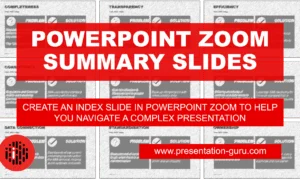
Powerpoint Zoom Summary for interactive presentations – everything you need to know
In this article I’ll be showing you how you can use Powerpoint Zoom to...

How to get over ‘Impostor Syndrome’ when you’re presenting
Everybody with a soul feels like an impostor sometimes. Even really confident and experienced...
Grab our webinar toolkit to transform your webinars from ordinary to extraordinary here

How to present like Steve Jobs during online webinars

Skip to contents
Very few brands are as recognisable as the Apple Brand. Since its inception, especially with the introduction of the iPhone, the company has firmly implanted itself into the fabric of popular culture. But Apple is not just a popular brand; it is also one of the biggest and most marketable brands on the planet, with customers and enthusiasts in every part of the world. The brand is so well-positioned that it now practically sells itself; there are people worldwide who would buy the next iPhone or Apple Watch, regardless of its features.
The success of Apple is not a fluke or a product of chance. On careful observation, you can trace a significant part of its initial success to the charisma and presentation prowess of its founder, Steve Jobs. Everyone old enough will surely remember when Jobs introduced the first iPhone during the 2007 Macworld Conference & Expo and how the audience went wild.
Today, despite the sad departure of Jobs, Apple continues the tradition of giving exceptional presentations—a tradition that has served them spectacularly well.
What makes Steve Jobs presentation skills spectacular
Good presentations do more than dish out information; the ultimate goal is to change how people view the subject or product you, and if possible, take the actions that you wish them to take, whether it be starting a healthy routine or purchasing your product. To do that, you need to captivate the audience with your body language and make an emotional connection; this is where Steve Jobs public speaking skills excels. This article will show you some tips to help you improve your online presentation by analyzing the presentation style of Steve Jobs.
Presentation secrets of Steve Jobs
Steve Jobs used many techniques to get his audience on the edge of their seats. His method stemmed from his belief that people didn't just buy what was valuable but also what they liked; he understood presentation makes all the difference. So he wanted to show them the importance and beauty of his product. Every presenter can learn valuable tips by considering some of these techniques. Here are some ways he went about it.
Build momentum before your online webinar or keynote

Many speakers make one mistake when they try to address a topic in the webinar session; they often deliver their speech at a straight, unchanging pace. While you may not necessarily be delivering your talk in a flat, monotonous drawl, this is still the worst way of presentation as you can still lose your audience.
This is because humans, especially now, can get increasingly bored if they are not excited about the presentation or feel the talk is going nowhere. One way of combating this problem is by building momentum. There are two ways you can do this:
- Set the theme
- Create a road map.
- Instil Anticipation
Steve Jobs did this perfectly when he unveiled the iPhone and even the macbook air. He did not allow his audience to wonder what the presentation would be about nor did he ramble on carelessly from one unrelated point to another. Rather, he structured his talk in a way that allowed him to link one point to another. He had a roadmap and it went something like this.
- He started with an announcement– he would launch three devices at the end of the day. Now, the audience was curious to see the devices.
- He went on to outline the logical and emotional value of these devices.
- Finally the big reveal. The three devices are, in fact, one device with multi-purpose value; it was a satisfying twist.
By giving his audience something to look forward to and ensuring he didn't spend much time discussing each of the most logically and emotionally appealing features, and by revealing something surprising, Jobs hooked the audience. From the beginning of the presentation, everyone was curious about the end, and he did not disappoint. You can use this technique to take your presentation to new, riveting levels.
Dish out information in small bites and sell the benefit
People struggle to remember bulky information, and you will never be as influential as you wish if your audience doesn't remember the information in the first place. Steve Jobs understood this concept well, so he boiled down his presentations to their core details. He used a principle called The Rule of Three- a vital concept in communication theory.
The rule of three principle suggests that when a group of topics, products, or characters are three in number, it gives the audience the most psychological satisfaction while also helping them retain the information. You can apply this principle by arranging your presentation in three parts; do this in the following three ways:
- Break up your presentation into tiny chunks, preferably arranging them to fit three sessions. The length of each segment should ideally be 10-15 minutes because that is the limit of most people's attention span.
- Input suitable relief material in between each session. It should be something lighter than what you are presenting. If possible, you can play a video or interview a satisfied customer. Steve Jobs used this technique when he made his first call using an iPhone during one of his presentation intervals.
- Highlight only the core values of the product, this way you don't include details that distract your audience from the main points.
Use story techniques

Every human on earth is easily affected by stories; they are how we learn lessons about the world. Good stories are not only entertaining but also memorable. You probably remember the plot of your favourite movie or the lyrics of your favourite song. Conversely, arranging your presentation using a story format can make your presentation engaging, relatable, and unforgettable. Here are some ways you can do this:
Introduce an antagonist (or a bad guy)
The Bad guy could be anything from a rival product that is not fulfilling the audience's needs, a gap in the industry that is highly inconvenient, or a terrible habit that is preventing the audience from reaching their goals. Emphasise how terrible it is and how the bad guy reduces the quality of their life.
Show your concerns and efforts
Next, briefly recount your desire to provide a solution or weapon they can use to combat this enemy that seeks to make their lives miserable. This part will show you as emphatic to their plight and bind you to them. But be careful not to dwell too much on this segment so you don't start sounding too sanctimonious.

Reveal the hero
Show how your products succeed in addressing the problems that you have outlined earlier. Ensure you imprint the necessity of making changes as the only solution to the audience’s problems (which usually requires purchasing the product). This empowers them through using your product - it is important to make the customer the hero of the story.
Make the presentation people-centered

An important thing to remember when making your presentation is that it isn't all about you. Your audience is not listening to you out of compassion; it is because there is a problem that needs solving, and they are interested in knowing how beneficial your presentation will be. Hence, the presentation should be audience-focused, not speaker-focused. There are some unique ways you can do this:
Capture audience imagination
You will have better success engaging and possibly influencing your audience when you capture their imagination. For example, Steve Jobs did not say "we have built a better phone"; instead, he said "we are putting 1000 music tracks into your hands". The second statement was better because it instantly made the audience think of a specific need the phone would solve.
Make numbers and figures relatable
We often take for granted that many people are blind to measurable parameters. We may know what a kilometre or a pound is, but until we compare it to something else, we cannot really sense the impact. Use this principle when you make your presentation; if there is any raw data, make sure to present it in a way that your audience can feel. For example, instead of saying the company uses a 128-bit encryption network, try saying: We use the same security used by the National Bank. This way, your audience can relate to your data and picture it in a way that holds meaning to them.
Create a sense of higher purpose
This part is essential especially in sales because people often hesitate to make purchases, possibly feeling guilty or scared at having to indulge themselves. You can overcome this feeling by giving the thought of buying the product a sense of nobility. When Steve Jobs presented the iphone, he offered his future customers the chance to be part of the phone reinvention. Suddenly they were not mere consumers but part of something extraordinary. You can apply that principle during your presentation. Only be careful not to lay it too heavily, or else you risk coming off as pretentious!
Keep the audience focused on you

You don't want the audience getting distracted by anything, not even the presenting aids you're using to get your points across. Some presenters often prepare such elaborate slides that they end up hugging all the audience's attention. Slides, pictures and audio-visual materials are a crucial part of your presentation. Still, you want to ensure you draw attention to yourself and what you're saying occasionally. Steve Jobs had an incredible stage presence, but he often included a blank slide that subconsciously made the audience focus back on him. Some presenters use a prop such as a laser pointer to grab attention. You have to look for effective but discreet ways to do this during your presentation.
Prepare properly

Although it often doesn't seem like it, Steve Jobs always knew to sweat the small stuff. He agonised over every product detail, ensuring he knew every facet of his story. When preparing for a presentation, Steve Jobs rehearsed and scripted every part of his presentation so as not to deviate from his outlined structure.
Even if scripting every word of your presentation isn't your style, you want to know what you're about to say. One way to do this is by writing your main points in a single sentence or as bullets, so that as you carry out your presentation, those points will remind you of what you should be talking about. This technique gives you the freedom of spontaneity while guiding you against derailing off-topic.
Finally, be sure to bring some humanity into your presentation. In todays world where AI is used in an increasing amount of communications, it's important to remember, as human beings we are capable of emotion and humour, engaging in our own unique way. You don't need to bring the house down with hilarious stories (although a good story always helps!), but in reality remembering to pause and smile at certain moments will bring warmth and help your audience build belief and trust in you and what you are presenting, even if it's not as exciting as a new iPhone!
Frequently Asked Question
How do you make a presentation like Steve Jobs?
Craft a narrative with a clear structure, use minimalistic slides, and prioritize visuals over text. Practice and master your delivery, focus on audience engagement, and infuse passion and enthusiasm into your presentation for a compelling and impactful style, akin to Steve Jobs.
How can I be confident on a webinar?
Prepare thoroughly, practice your content, and familiarize yourself with the best webinar platform . Maintain a positive mindset, engage with your audience, and remember that expertise and enthusiasm will boost your confidence during the presentation.

Subscribe now to receive monthly offers, news and industry insights.
Recommended Blogs

How to Host Engaging Webinars - Tips & Ideas
Learn how to create powerful webinars that captivate your audience. From choosing the right format and content to engaging participants with polls and Q&A sessions, this guide covers everything you need for a successful virtual event. Start hosting effective webinars that leave a lasting impact on your audience.

How to host a successful webinar
Unveil the secrets to a flawless webinar experience with our comprehensive blog. From choosing the ideal webinar platform tailored to your goals, to captivating your audience with interactive engagement, we've got you covered. Level up your virtual events and leave a lasting impact - read the full guide now!

The ultimate guide to virtual meetings
The business benefits of online meetings attract many companies to spend money in this space. The interesting point is that online virtual meetings have so many benefits worth exploring today. But if you have been sitting on the attendee side for so long, this ultimate guide is for you.

Create engaging video experiences
Get access to everything you need to meet, present and teach online
No credit card needed. No downloads.
.webp)
Proudly part of the Stripe Climate Initiate
Table of Contents
Get our weekly newsletter.
Subscribe to our newsletter for webinar and virtual engagement business insights
Latest writings

The benefits of webinars in the education sector
Webinars have grown in popularity and consumption over the years and have been increasingly used by industry leaders across multiple sectors. Online marketers have used them extensively in lead generation, while financial institutions and even health professionals have found them useful in some capacity. However, when webinars are mentioned, a sector usually goes unmentioned— this is the education sector.

5 Tips for conducting remote job interviews
Remote interviews and hiring remote workers have become the recent trend in business. Most countries still observe the COVID-19 pandemic prevention routine incorporating remote jobs and hiring. This article is geared towards defining who a remote worker is, providing remote interview tips and essential tools for conducting a remote interview and describing the importance of Cloudpresenter as a webinar software for remote interviews.

How to become a corporate trainer
Many people are passionate about teaching and ensuring that others learn from them. This is what a great corporate trainer does. Within every company, these sets of people tend to assist new employees in getting acquainted with the rudiments of their new workplace.

“We’ve been using Cloudpresenter to expertly bring our series of webinars to life, increasing attendance and engagement"

5 Presentation lessons you can learn from Steve Jobs
Become a storyteller.
- Flat Design
- Minimalist Design
- Colorful, Bright, and Bold Design
- Infographic-Style Slides in Presentations
- Bold Typography Design

Steve Jobs was a master of public speaking, and although it may seem like he had all the secrets to a successful presentation, he used some rather basic ideas about how to do it that… ... read more Steve Jobs was a master of public speaking, and although it may seem like he had all the secrets to a successful presentation, he used some rather basic ideas about how to do it that you can use today. Here are five presentations from his keynote speeches that you can learn from. close
Steve Jobs was one of the most innovative leaders of our time. Among other things, there is a lot that can be learned from him when it comes to presentation design and what aspects of his presentations made them so memorable and entertaining. Some would argue that he was the one person who completely changed our minds about what makes a presentation great—in a world of long, boring, and unimaginative slides, he used presentation techniques that followed a completely different approach.
In this piece, we thought it would be a good idea to go over the five principles that Steve Jobs followed when it came to presentation design and delivery. So let’s jump right into it.
How did Jobs give incredible presentations?
Steve Jobs was known for the friendly and open demeanor he had while presenting. He avoided technical vernacular and kept his ideas straightforward with quick, memorable titles. Jobs was a showman. He was enthusiastic and told stories, he had confident body language and told jokes, which made him appear more approachable. What can we learn from him as we practice and prepare our own presentations?
01 Use a compelling theme & title
Come up with a headline and general theme for your presentation that run through the entire deck as an underlying message. This headline should be short enough to be easily memorable and tweetable. Think back to Steve Jobs’ iPhone launch in 2007, when his headline was “Your life in Your Pocket.” This quick slogan summed up his whole message and was memorable enough for the audience to carry with them even after the presentation. Think about the theme of your presentation. What do you want the audience to walk away remembering? Now simplify it into one, all-encompassing catchphrase.
02 Engage the audience by telling a story

Tell a story that hits people at an emotional level. It’s a well-known fact that stories are one of the most powerful tools that leaders use to inspire, motivate, and educate. This is because stories are far easier to remember than facts and figures. And research, according to psychologist J erome Bruner, points to the fact that facts are 20 times more likely to be remembered if they are embedded in or contextualized with a story .
Like Steve Jobs, you could frame your narrative around defeating an antagonist—the problem at hand. Introduce yourself or your company as the hero. Paint a picture of how your product or service defeated this problem and emerged victorious.
03 Simplify bigger numbers

Simplify large numbers. This ensures that people can grasp the facts better. For instance, Steve Jobs would say, “We sold 2 million iPods in the first 59 days.” And then he would give context by adding, “That’s nearly 34 thousand iPods sold every single day.” In February 2013, Apple reached 25 billion songs downloaded from iTunes, and he simplified the number so it was easier to understand. For instance, he’d say, “On average, that’s 15,000 songs every minute.” His whole approach was about simplifying big ideas. Don’t leave the audience confused, connect the dots and explain the relevance these numbers have to them.
04 Use compelling visuals
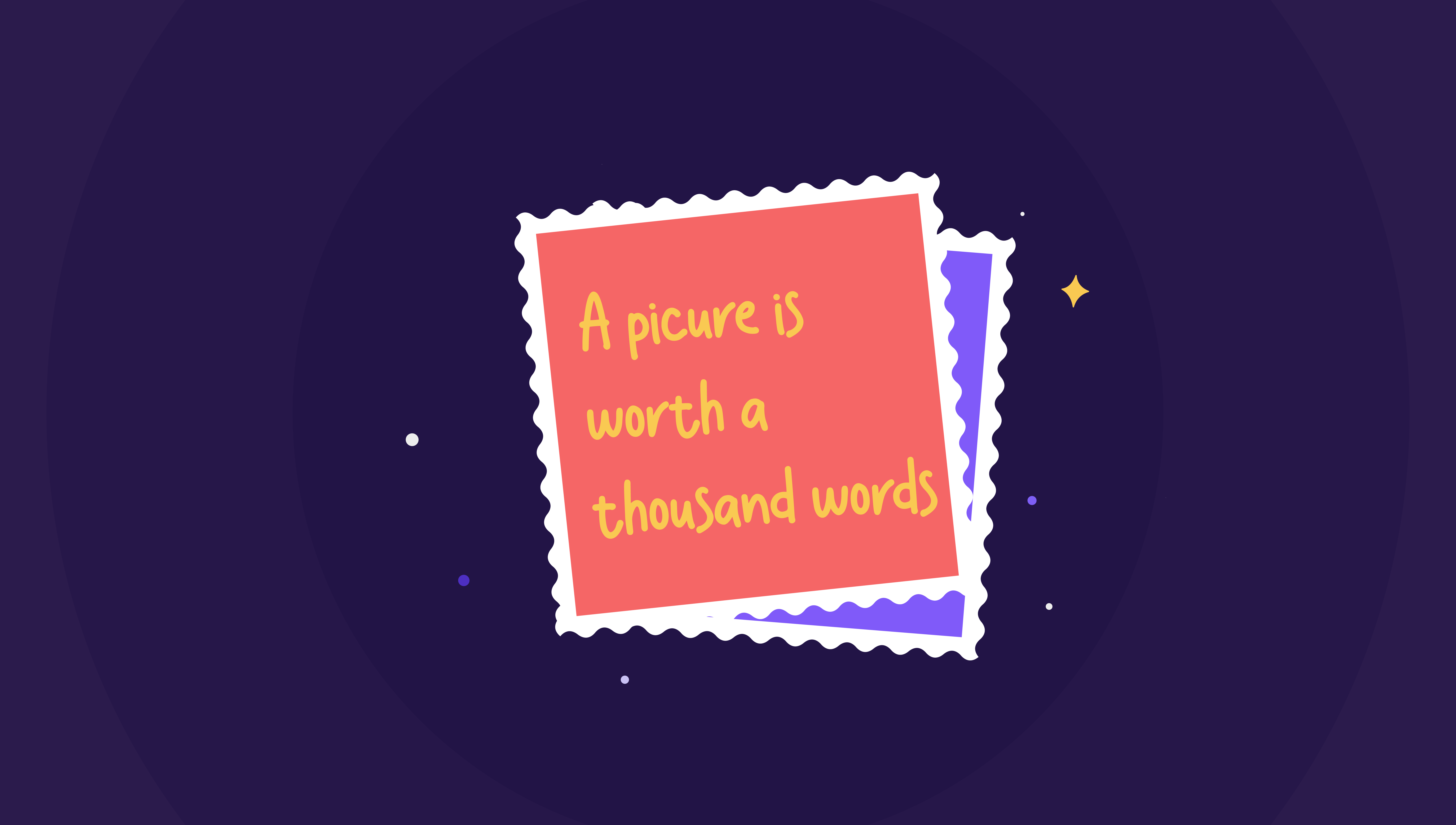
Studies find that using images boosts information retention. Since most people are visual learners, they can pick up on the information shared in a presentation when shared as an image.
Jobs used big, bold, and clear pictures and rarely used more than two images on a presentation slide. In the 2007 launch of the iPhone, he used three images to highlight that the iPhone could do all three things—be a phone, a music player, and give you internet access. Then he quickly moved on to his normal procedure of using one striking image.
05 When it comes to words, less is more

Use fewer words. If you want a presentation like Steve’s, you will have to edit and re-edit your words. Leave only the most important phrases and cut out everything else. The idea is to communicate your message in the most impactful and memorable way possible, rather than having your audience read slides full of text. So he would use words like “magic” instead of the full, grammatically correct sentence “it works like magic,” and similarly, he would use “no stylus” instead of “it has no stylus.” You get the idea!
Jeff Black, the founder of the leadership development company Black Sheep, says that Steve’s presentations boiled down to three key factors: powerful storytelling, emotional connection, and obsessive preparation. Black says the late Steve Jobs was a masterful storyteller. “He was the messenger, he was the star of the show — not the PowerPoint slide.”
And one more thing… the average PowerPoint slide has on average forty words. Steve Jobs would use an average of nineteen words across 10–12 slides. That’s the presentation zen.
If you are interested in learning more about designing a presentation like Steve Jobs, we recommend the book “The Presentation Secrets of Steve Jobs: How to Be Insanely Great in Front of Any Audience.” Or you can just reach out to professional presentation design services in Dubai and across the GCC—we specialize in not only delivering your message but also helping you tell your story and push your brand forward.
Let us design your presentation!
Recommended for you..

05 March 2024
The Pyramid Principle: The game-changing communication tool

12 March 2024
Persuasive storytelling for consulting presentations

27 December 2023
8 Presentation design trends you should know about for 2024

- Business & Money
- Management & Leadership

Download the free Kindle app and start reading Kindle books instantly on your smartphone, tablet, or computer - no Kindle device required .
Read instantly on your browser with Kindle for Web.
Using your mobile phone camera - scan the code below and download the Kindle app.

Image Unavailable

- To view this video download Flash Player
Follow the author

The Presentation Secrets of Steve Jobs: How to Be Insanely Great in Front of Any Audience MP3 CD – MP3 Audio, October 1, 2012
- Language English
- Publisher Brilliance Audio
- Publication date October 1, 2012
- Dimensions 5.25 x 0.5 x 6.75 inches
- ISBN-10 146923033X
- ISBN-13 978-1469230337
- See all details

Similar items that may deliver to you quickly

Editorial Reviews
About the author, product details.
- Publisher : Brilliance Audio; Unabridged edition (October 1, 2012)
- Language : English
- ISBN-10 : 146923033X
- ISBN-13 : 978-1469230337
- Item Weight : 4 ounces
- Dimensions : 5.25 x 0.5 x 6.75 inches
About the author
Carmine gallo.
Carmine Gallo is a popular keynote speaker, Harvard instructor, and communication advisor for the world's most admired brands. His new book is FIVE STARS: The Communication Secrets to Get From Good to Great. Gallo is the author of 9 books including international bestsellers: Talk Like TED, The Presentation Secrets of Steve Jobs, The Apple Experience, and The Storyteller's Secret. Join Carmine's list at carminegallo.com and follow him on Twitter @carminegallo.
Customer reviews
Customer Reviews, including Product Star Ratings help customers to learn more about the product and decide whether it is the right product for them.
To calculate the overall star rating and percentage breakdown by star, we don’t use a simple average. Instead, our system considers things like how recent a review is and if the reviewer bought the item on Amazon. It also analyzed reviews to verify trustworthiness.
Reviews with images

- Sort reviews by Top reviews Most recent Top reviews
Top reviews from the United States
There was a problem filtering reviews right now. please try again later..

Top reviews from other countries
- Amazon Newsletter
- About Amazon
- Accessibility
- Sustainability
- Press Center
- Investor Relations
- Amazon Devices
- Amazon Science
- Start Selling with Amazon
- Sell apps on Amazon
- Supply to Amazon
- Protect & Build Your Brand
- Become an Affiliate
- Become a Delivery Driver
- Start a Package Delivery Business
- Advertise Your Products
- Self-Publish with Us
- Host an Amazon Hub
- › See More Ways to Make Money
- Amazon Visa
- Amazon Store Card
- Amazon Secured Card
- Amazon Business Card
- Shop with Points
- Credit Card Marketplace
- Reload Your Balance
- Amazon Currency Converter
- Your Account
- Your Orders
- Shipping Rates & Policies
- Amazon Prime
- Returns & Replacements
- Manage Your Content and Devices
- Recalls and Product Safety Alerts
- Conditions of Use
- Privacy Notice
- Consumer Health Data Privacy Disclosure
- Your Ads Privacy Choices
Tips for creating the best presentation
Tips Trick and Technique for creating and delivering Powerpoint and Keynote Presentation

5 Presentation Techniques From Steve Jobs
March 28, 2018 by Muhammad Noer
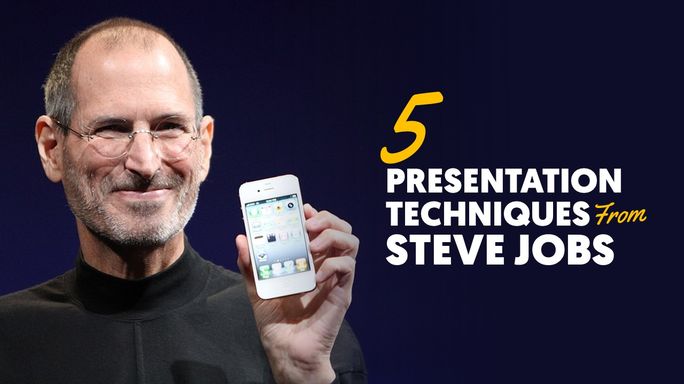
Jobs’ performance on a presentation is always expected and waited by many people. Through the world-class exclusive presentation technique, he performs how to deliver a presentation in a unique way, like an attractive show, successfully. Here are some techniques used by Jobs that lead him to be a successful presenter.
1. Create stories as a background to your presentation
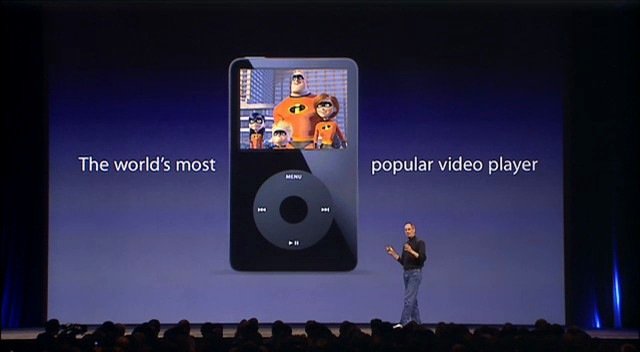
The first secret is how you create a story behind a presentation. Everyone loves story. The presentation that has a story in it will always be remembered by the audiences.
The reason is very simple, stories are easily remembered. That is why you will always remember your childhood’s stories told by your parents. The audiences will remember your stories and forget anything else.
Steve jobs masters this technique properly. In every presentation he always delivers a story. When he introduced iPod in 2001, he did not explain iPod as a merely MP3 player. He chose to tell a story about iPod as 1000 songs in your pocket.
2. Create simple but visually strong slides
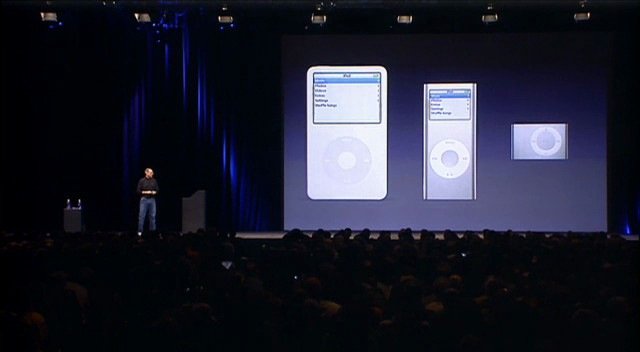
A good slide is usually not a complicated one. A good slide is a simple one, accurate, and helping the audiences to grasp quickly the idea that the presenter wants to deliver.
In every presentation, Steve Jobs always uses very simple slides. Sometimes, they contain just pictures with no words. In another time, they contain numbers, typed with big font size.
Through the appropriate pictures, he wants to evoke the audience’s imagination to imagine what he is explaining.
3. Use three parts rule
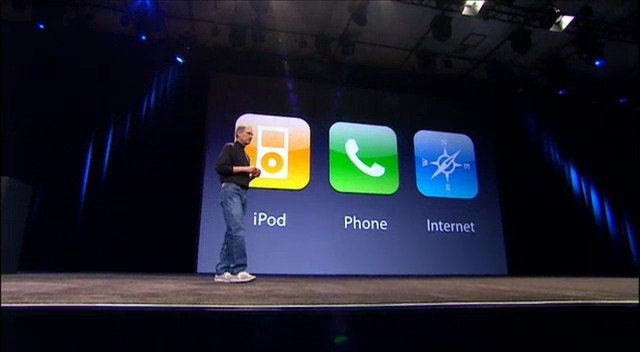
In the process of making a speech, we know a term three parts rule. It is done because people are used to understanding many things through three parts.
Jobs knows very well the strength behind this rule so that he uses this trick in many occasions. When he explained about iPhone, Jobs did not tell too many things that can lead people into confusion.
He summarized it as a revolutionary cell phone that has three function: (a) as an entertaining iPod, (b) as a smart phone, and (c) as a great internet communication media. Through these three things, the audiences could easily remember what iPhone is and they could summarize all other features.
The audiences can hardly remember more than three things. On the other side, less than 3 things are too little that makes presentation uninteresting. Use three parts of information to create strength to your presentation.
4. Help the audiences understand the statistics and data
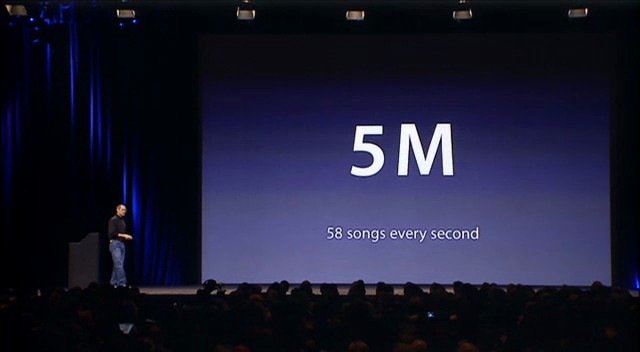
Sometimes a presentation needs statistics and data to deliver important information to the audiences. Unfortunately, statistics and data sometimes are boring.
The question is how to make statistics and data more interesting? Remember! The audiences don’t care about the number you show in your presentation. They do pay attention to the story behind those numbers.
When he explained about the amount of songs that had been downloaded through iTunes, he delivered simple data by saying that 2 billion songs have been downloaded. It means 5 million songs have been downloaded per day.
It also means in a second, there are 58 songs downloaded. To make the audiences easy to imagine, he added, “This happens every minute in every hour every day.”
Now, notice how he could deliver an interesting story behind numbers and statistics. If the audiences were just given data that 2 billion songs had been sold or 5 million songs were sold per day, the audiences would hardly imagine the meaning of the statistics.
When Jobs helped the audiences by telling an analogy that there were 58 thousand songs were sold per second, the audiences could easily imagine that that was a huge amount of songs that had been downloaded.
5. Create extraordinary surprise momentum
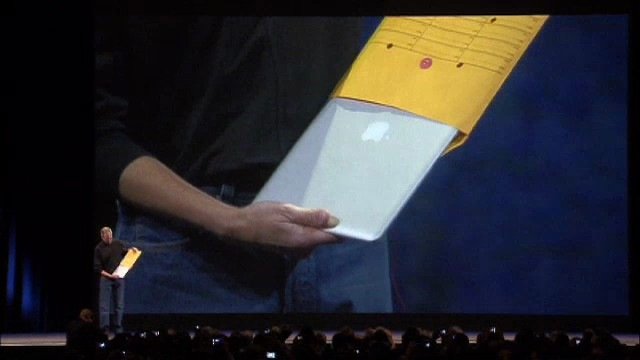
A great presentation has something that surprises the audiences. If you want to perform greatly, create a surprise momentum to the audiences. This was what Jobs did in his presentation in 2008: he told that apple had made the thinnest notebook in the world. He showed a picture that showed how thin and light the notebook was.
When the audiences tried to imagine how thin this was, Jobs suddenly took an envelope and take a MacBook Air out of the envelope and showed it to the audiences. They were shocked and mesmerized. He created a surprise momentum in his presentation successfully. Actually, he could just explain about the product monotonously, but it would not give strength and emotional aspect to his presentation.
By taking out a MacBook out of the envelope, the explanation about the thinnest notebook was perfectly delivered. There was no technical explanation needed.
For you who want to be an extraordinary presenter, think and create the surprise momentum that summarized the whole presentation that will be remembered by the whole audiences.
Those are some techniques used by Jobs that make him famous and loved by many people. If you use and apply these techniques, every chance you have will be the mesmerizing presentation to the audiences.
If you want further understanding about these techniques, you can read book entitled “The Presentation Secrets of Steve Jobs – How to Be Insanely Great in Front of Any Audience” written by Carmine Gallo, a columnist in Businessweek.com.
Download Inspiring Presentation

Simply complete the form below and click download. We will send you two Inspiring Slides. FREE!

About Muhammad Noer
Muhammad Noer is a Human Resources Professional who has passion in sharing how to create and deliver a great presentation.
Best Presentation is aiming to give you practical tips on how to create a great presentation. We believe everyone can learn how to create a better presentation, deliver a great speech and show amazing visual slides.
We created wide-ranging presentations template products from Inspiring Slides to Powerful Business Presentation. Click below for the products:
- WOW Presentation
- Inspiring Slides
Email: [email protected]
Address: Level 38, Tower A, Kota Kasablanka Jl. Casablanca Raya Kav 88 Jakarta – INDONESIA
Home Top – Download

Recent Post
- How to Reduce PowerPoint File Size: 3 Quick Tips To Help You Out
- Want Your Audience Keep Listening to You? Check This Out!
- Start Your Presentation with Villain
- How to Use Storytelling in Presentations
- 5 Things to Remember Before Doing Online Presentation

IMAGES
VIDEO
COMMENTS
Steve Jobs educated, entertained, informed, and inspired his audiences in every presentation. So can you. It takes work, planning, and creativity, but if someone is willing to listen to your ideas ...
Steve Jobs employed the following techniques to his advantage: 1. Simplicity and Clarity. Simplicity and clarity are crucial factors for all types of presentations. Nobody wants to hear complex content delivered in the most convoluted way.
When it comes to presentations, most people who've seen him speak agree that Steve Jobs is a legend. His talks do much more than just give information. They're events. They inspire, excite, spark imagination, and build a following. Seeing Jobs speak is like spending an evening watching a high-quality theater production.
Give effective, dynamic, and memorable presentations just like Steve Jobs. Based on the author's article on Businessweek.com, which became one of the site's most popular downloads, The Presentation Secrets of Steve Jobs breaks down the 10 elements that make Steve Jobs' legendary presentations so outstanding. Readers implementing these principles to their own presentations are sure to ...
Now you can learn the exact techniques that made Jobs the most captivating storyteller on the business stage. In The Presentation Secrets of Steve Jobs Carmine Gallo maps out a ready-to-use framework to help you plan, deliver and refine the best presentation of your life. One major construction company scored an $875 million contract after ...
Steve Jobs turned presentations into an art form because he approached keynote presentations like an artist. Musicians, actors, and designers master their crafts over many hours— 10,000 hours ...
Follow these steps to build your presentation confidence and wow your audiences. 1. Start rehearsing early. Former Apple software engineer Ken Kocienda once told me that one of Jobs's "great ...
1. "Design is a funny word. Some people think design means how it looks. But of course, if you dig deeper, it's really how it works. The design of the Mac wasn't what it looked like, although that was part of it. Primarily, it was how it worked. To design something really well, you have to get it.
What makes Steve Jobs presentation skills spectacular. Good presentations do more than dish out information; the ultimate goal is to change how people view the subject or product you, and if possible, take the actions that you wish them to take, whether it be starting a healthy routine or purchasing your product. To do that, you need to ...
The Wall Street Journal Bestseller!. Updated to include Steve Jobs's iPad and iPad2 launch presentations "The Presentation Secrets of Steve Jobs reveals the operating system behind any great presentation and provides you with a quick-start guide to design your own passionate interfaces with your audiences." —Cliff Atkinson, author of Beyond Bullet Points and The Activist Audience
1. Tell a story. Steve Jobs told stories, usually about how Apple technology would change the world. Like all good stories, his had a beginning, middle and end. More to the point, they had heroes ...
The Presentation Secrets of Steve Jobs is a book that a speechwriter can love. Gallo quotes from sources such as Nancy Duarte's slide:ology: The Art and Science of Creating Great Presentations and Garr Reynolds' Presentation Zen: Simple Ideas on Presentation Design and Delivery. He even has a sidebar on JFK speechwriter Ted Sorensen's influence ...
01 Use a compelling theme & title. 02 Engage the audience by telling a story. 03 Simplify bigger numbers. 04 Use compelling visuals. 05 When it comes to words, less is more. Summary. Steve Jobs was a master of public speaking, and although it may seem like he had all the secrets to a successful presentation, he used some rather basic ideas ...
June 24, 2013. The Presentation Secrets of Steve Jobs is a book that a speechwriter can love. Gallo quotes from sources such as Nancy Duarte's slide:ology: The Art and Science of Creating Great Presentations and Garr Reynolds' Presentation Zen: Simple Ideas on Presentation Design and Delivery. He even has a sidebar on JFK speechwriter Ted ...
3) Simplify Big Numbers. Simplify big numbers — A LOT. This ensures that people can grasp the facts better. For instance, Steve Jobs would say "We sold 2 million iPods in the first 59 days ...
Learn how to present like Steve Jobs. Practise your presentation skills and improve your Business English. For a full transcription of the video, go to the b...
Steve Jobs said during a MacWorld keynote in 2007 and this was defin... "Every once in a while, a revolutionary product comes along that changes everything ..." Steve Jobs said during a MacWorld ...
In his presentation, Steve Jobs also often told many entertaining stories and jokes to keep his audience's attention. 5. Be natural A key to a good presentation is to keep eye contact with the audience. In the introduction of the iPhone, the presentation lasted about 80 minutes. During the 80 minutes of the presentation, not once did Steve ...
Whether he was introducing the latest iPad or delivering a keynote presentation, Steve Jobs electrified audiences with his incomparable style and showmanship. He didn't just convey information in his presentations; he told a story, painted a picture, and shared a vision. He gave his audience a transformative experience that was unique ...
Just follow the five-step rehearsal strategy that made the public speaking of Steve Jobs the gold standard for business presentations. 1. Start rehearsing early. Jobs committed to rehearsing his ...
In 2007, Todd Bishop, a reporter for the Seattle Post Intelligencer, compared word choice between Apple's Steve Jobs and Microsoft's Bill Gates by running their presentation transcripts through UsingEnglish.com, a language analyzer. 15 The tool examines the average number of words per sentence, lexical density, average number of words with ...
Here are some techniques used by Jobs that lead him to be a successful presenter. 1. Create stories as a background to your presentation. The first secret is how you create a story behind a presentation. Everyone loves story. The presentation that has a story in it will always be remembered by the audiences.
A presentation on "Steve Jobs". Steve Jobs was born in 1955 and adopted by Paul and Clara Jobs. He dropped out of college but still attended classes. Jobs met Steve Wozniak and they developed the Apple I computer in 1976, founding Apple Computers. Jobs led Apple to success with products like the Macintosh in 1984 and iPod, but left the company ...